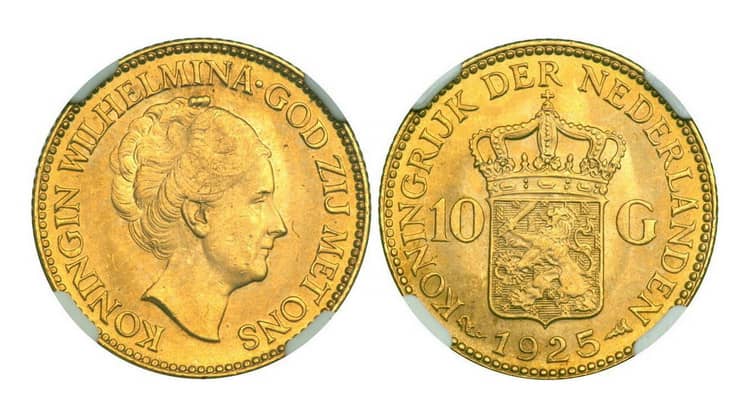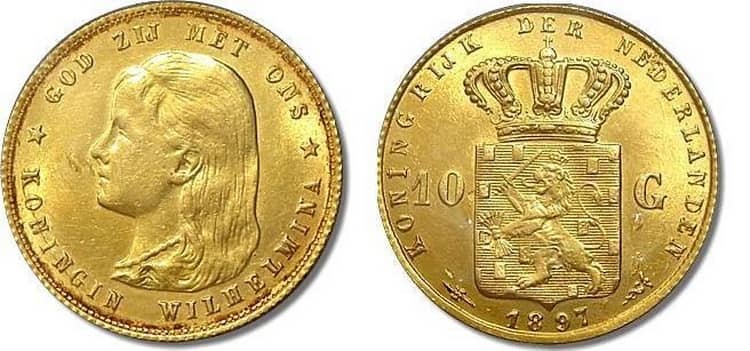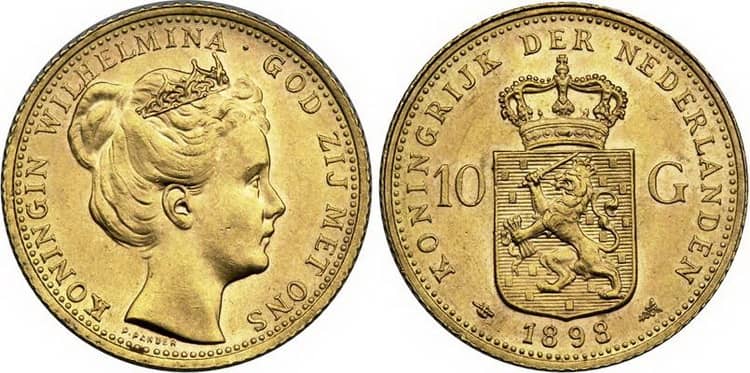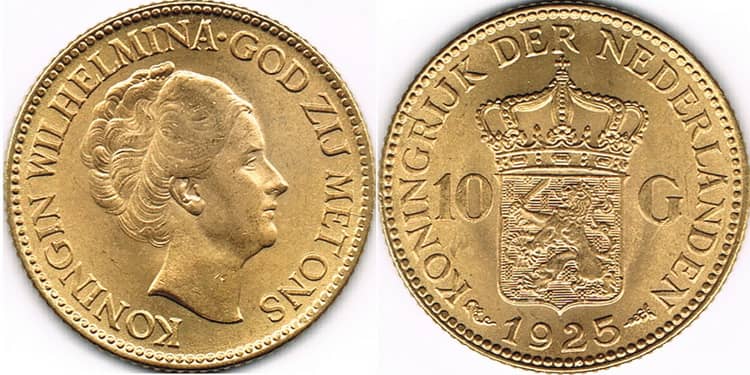
10 Dutch guilders (of 1875-1933) is a series of gold coins with a rich history. Starting from the XVIIth century, they served as a symbol of stability and reliability, which makes them an excellent addition to any numismatic collection. The fact that the circulation of 1933 was the last because of the Great Depression, and then the impending World War II, further enhances the rating of the coin.
History
The first guilders appeared in the Netherlands in 1680, when the king decided to replace florin with his own national currency from silver reserves. In 1816, the first samples of gold appeared. The denomination of the coins was 10 guilders. For a long time, the kingdom successfully used Dutch gold and silver coins with the exception of the war period when Germany began to occupy, and until the euro was introduced in 2002.

Over the entire period, four series of 10 guilders coins were minted in the Netherlands. The most interesting samples were minted from 1875 to 1933. During this period, the Royal Dutch Mint minted two types of coins. Samples of the first series were decorated with a portrait of the monarch William III (the last Prince of Orange-Nassau). The king, who had been ruling for 41 years, carried out a number of successful reforms, which led to peace and prosperity in the country, and also significantly improved the living standard of ordinary Dutch people.
Did you know? The last 10 gold guilders were minted in 1933, when the Netherlands touched on the aftermath of the Great Depression. In fact, it was one of the last European countries where production of circulating coins made of precious metals was suspended. France and Germany stopped minting during the First World War. England temporarily stopped mintage in 1932. And although 10 guilders of gold disappeared from circulation more than half a century ago, they have since been assigned a new role in numismatics. Modern samples of precious metals began to be minted as investment coins.
Before King William III came to the throne, the Netherlands fell into decay from various economic crises, epidemics and natural disasters. Such hardships markedly slowed the development of the kingdom on the background of the neighboring countries of Europe. During the monarch’s reign, from 1850 to 1890, a cardinal change in industrial production, export promotion, the construction of several ports, a railway (2,000 kilometers) and additional channels provoked rapid economic growth.

Coins with the image of the monarch minted from 1875 to 1889:
- 1875 − 4,110,011 pcs.
- 1876 − 1,581,106 pcs.
- 1877 − 1 108 149 pcs.
- 1879 − 581,036 pcs.
- 1880 − 50,100 pcs.
- 1885 − 67,095 pcs.
- 1886 − 51,141 pcs.
- 1887 − 40,754 pcs.
- 1888 − 35,585 pcs.
- 1889 − 204,681 pcs.
Over the entire period of the monarch’s reign, the Royal Mint produced 7,800,000 coins of 10 guilders denomination, but some were melted or underwent considerable damage during circulation.
Did you know? The medieval roots of the guilder can be seen in its abbreviation HFL − Holland florin. At that time, the Dutch merchants produced their own version of florin, until the guilders (after the fall of the Napoleonic empire) turned into a monetary unit. On the coins (one of the first) the inscription on the rim was minted. This was supposed to stop people from fraud − cut the precious metal in their favor.
In 1890, the king’s place was taken by his daughter, the ten-year-old Queen Wilhelmina (until the age of 18, the regent was her mother, Queen Emma). She is known as the most long-term monarch in the history of the Netherlands (from 1890 to 1948). For such a long period, she had to share with the people both light and dark times, including the First and Second World War, the peak of the Great Depression (1929-1933). For her country, she represents a symbol of resistance and unity due to the fact that she refused to submit to the invaders in May 1940.

Queen Wilhelmina I, as well as the coins minted during her reign, were in demand both from the Dutch and from residents of other countries. Due to the fact that she successfully coped with the affairs of her state, she was recognized as one of the richest women in the world and the first woman billionaire. But despite the wealth, she led a very modest lifestyle, therefore, personified virtue and was popular among her people.
Design
The main characteristics of 10 guilders for the entire period of minting did not change (except for the design):
- material − 90% gold, 10% copper
- purity − 900/1000
- weight − 6.73 grams (6.06 grams of gold)
- diameter − 22.5 mm
- thickness − 1.20 mm
- choke − ribbed
The obverse of 10 guilders of 1875-1889 is decorated with a portrait of the king. On top of the coin there is an inscription GOD ZIJ MET ONS (God with us). At the bottom of the legend is “KONIG WILLEM DE DERDE” (King William III). Both inscriptions are separated by five-pointed stars, the size of which changed in 1876.

The reverse of the 10 guilders of 1875-1889 contains the national emblem of the Netherlands in the form of a crowned shield that adorns the lion with a sword and arrows. On top of the semicircle there is the inscription “KONINGRIJK DER NEDERLANDEN”, denomination and year of issue (surrounded by skate and caduceus as a symbol of a powerful army and successful trade).
Did you know? During World War II, a battle was waged for a common currency. The occupation Nazi administration canceled the silver guilders and ordered the transfer of all the old coins in favor of Germany. But the Dutch government, exiled in Canada, filed a counter appeal through a London radio station, promising that the old Dutch coins would still be valid after the war. For this reason, few people gave their coins to the Germans.
10 guilders of Wilhelmina I were minted in four versions:
- 1890-1898 − portrait of a young Queen with flowing hair (the rarest)
- 1899-1910 − the image of matured Wilhelmina I at the time of the heyday of the country
- 1911–1917 − a portrait of the Queen in her old age with hair tucked into a bun (by Johannes Cornelis Vineck)
- 1925-1933 − a slightly smaller portrait of the Queen, the bust is truncated, and there is no tiara on her head.
Around the circle of 10 guilders coins from left to right there is an inscription “KONINGIN WILHELMINA” (Queen of Wilhelmina) and “GOD ZIJ MET ONS” (God with Us).
Circulation
Over the entire rule of Queen Wilhelmina I, the Dutch Royal Mint of Utrecht produced more than 22,000,000 coins. This number includes memorable samples minted in as Proof.
Known circulation of 10 guilders:
- 1897 − 453 696 pcs.
- 1998 − 99,239 pcs.
- 1911 − 774 544 pcs.
- 1912 − 3,000,000 pcs.
- 1913 − 1,113,476 pcs.
- 1917 − 4,000,000 pcs.
- 1925 − 2,000,000 pcs.
- 1926 − 2,500,000 pcs.
- 1927 − 1,000,000 pcs.
- 1932 − 4,323,952 pcs.
- 1933 − 2,462,101 pcs.
Did you know? At the end of the XVIII − beginning of the XIX century, the income of the average merchant was 150 guilders of silver per year. For 300 silver coins, 10 fattened pigs could be purchased, and for 100 − print or etching by the great Rembrandt Harmenszoon van Rijn. The carpenter received about 250 coins per year.
The cost of coins
The most in demand are 10 guilders of King Willem III, minted in 1877. The cost of the gold coin at numismatic auctions reaches $ 300 (good quality) and $ 270 (quality below XF).
Comments
No commens yet.